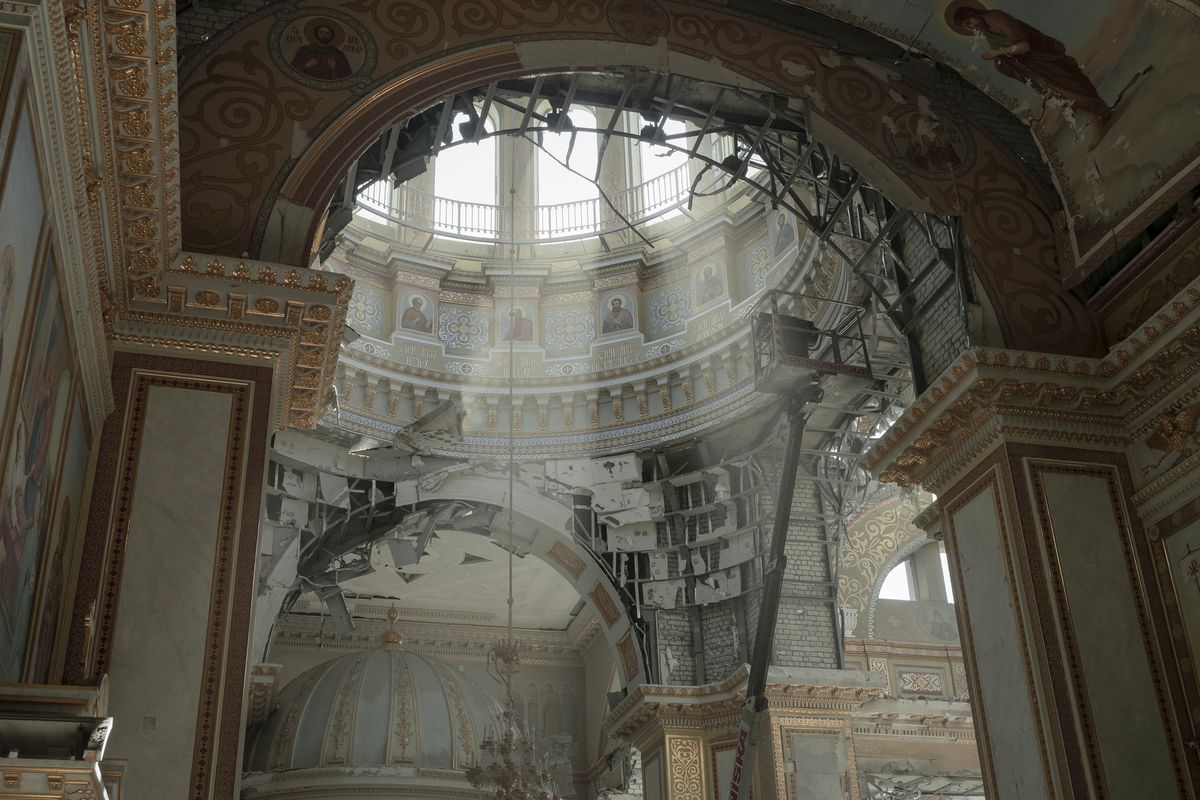In a heavily damaged Odesa cathedral, mass is held

ODESA, Ukraine — There are no walls behind the altar of Transfiguration Cathedral, the Odesa landmark that was heavily damaged on Sunday when Russian missiles struck the port city.
So when the breeze from the nearby Black Sea blows, it interrupts the stillness inside one of Ukraine’s largest places of worship, and a dangling chandelier in the nave swings like a slow pendulum from side to side. Detritus floats down from the roof, as workers, United Nations employees and priests don hard hats to inspect the damage to an icon of the city’s cultural heritage.
“We hope God will protect the heart of our cathedral,” said the Rev. Oleksii, who gave only his first name, after a morning Mass held in front of the red-and-white caution tape roping off the main part of the church.
Outside, residents gathered around the entrance to the cathedral, which is now boarded up with plywood. Many stopped to kiss an icon of the patroness of their city, which an employee of the church said had been pulled from the rubble. Others walked by to witness the destruction.
Founded in 1794, the cathedral became the most important church in Novorossiya, the name given by the Russian Empire to land along the Black Sea and Crimea that is part of present-day Ukraine. It was destroyed during a Soviet campaign against religion in 1936 and was not rebuilt until after the fall of the Soviet Union.
“This is inhumanity,” said Ludmila Partinchuk, who came by with her husband, Oleh.
Ludmila Partinchuk said that getting rest during the past week had been “a big problem” because “when you feel the night coming, you cannot go to sleep.”
The repeated missile strikes this week are new for Odesa, which has largely been spared from the widespread attacks that have hit cities including nearby Mykolaiv and the capital, Kyiv.
“Before, the Russians focused on targeting us with drones and most were shot down,” said Petro Obukhov, a member of the Odesa City Council. The Black Sea Grain initiative, a compromise brokered by the United Nations and Turkey to allow Ukraine to continue shipping grain from its Black Sea ports, also provided a modicum of security until Moscow pulled out of it a week ago.
“We felt we were relatively safe, but now this feeling is gone,”Obukhov said.
Odesa has been one of the most visited cities in Ukraine for domestic and foreign tourists, drawn by its cobble-stoned city center, much of it built in the late 19th century. Its history as a port city resulted in a widely diverse corner of Ukraine, with French, Italian and Greek merchants mixing with Ukrainian, Russian and Jewish families. On Tuesday, many of the cafes and restaurants were largely empty.
“Many tourists are staying away,” said Oleksii Khalykhin, 20, a tour guide, who said he was continuing his work so that locals and visitors could get a deeper sense of Odesa’s diverse history — and remember it in case it is obliterated.
“They are trying to destroy the identity of the city, he said. “Now we are trying to do everything possible to make sure that Odesa’s culture and heritage lives in the souls of its people.”
This article originally appeared in The New York Times.